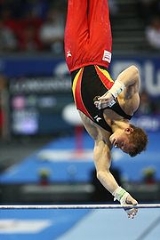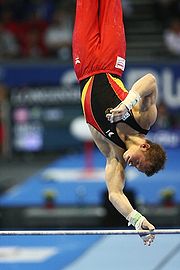
Horizontal bar
Encyclopedia


Male
Male refers to the biological sex of an organism, or part of an organism, which produces small mobile gametes, called spermatozoa. Each spermatozoon can fuse with a larger female gamete or ovum, in the process of fertilization...
gymnast
Gymnast
Gymnasts are people who participate in the sports of either artistic gymnastics, trampolining, or rhythmic gymnastics.See gymnasium for the origin of the word gymnast from gymnastikos.-Female artistic:Australia...
s in Artistic Gymnastics
Artistic gymnastics
Artistic gymnastics is a discipline of gymnastics where gymnasts perform short routines on different apparatus, with less time for vaulting . The sport is governed by the Federation Internationale de Gymnastique , which designs the Code of Points and regulates all aspects of international elite...
. It traditionally consists of a cylindrical metal
Metal
A metal , is an element, compound, or alloy that is a good conductor of both electricity and heat. Metals are usually malleable and shiny, that is they reflect most of incident light...
(typically steel
Steel
Steel is an alloy that consists mostly of iron and has a carbon content between 0.2% and 2.1% by weight, depending on the grade. Carbon is the most common alloying material for iron, but various other alloying elements are used, such as manganese, chromium, vanadium, and tungsten...
) bar that is rigidly held above and parallel to the floor by a system of cables and stiff vertical supports. Gymnasts typically wear leather grip
Grip (gymnastics)
Grips are devices that are worn on the hands of artistic gymnasts when performing on various gymnastics apparatus. They are worn by female gymnasts on the uneven bars, and by male gymnasts on the high bar, still rings and parallel bars...
s while performing on the bar. Current elite-level competition uses a more elastic fiberglass
Fiberglass
Glass fiber is a material consisting of numerous extremely fine fibers of glass.Glassmakers throughout history have experimented with glass fibers, but mass manufacture of glass fiber was only made possible with the invention of finer machine tooling...
core rail similar in material to the rails used in the women's uneven bars and men's parallel bars apparatus.
The gymnastics elements performed on the horizontal bar are regulated by a Code of Points
Code of Points (artistic gymnastics)
A Code of Points is a rulebook that defines the scoring system for each level of competition in gymnastics. There is no unified, international code of points; every oversight organization—such as FIG , NCAA Gymnastics, and most national gymnastics federations—designs and employs its own unique Code...
. A bar routine, which is a sequence of several bar skills, usually includes giant swings with various grips (overgrip, undergrip, dorsal grip, mixed grip), in-bar work, turns, release and regrasp skills, and a dismount. The high bar is often considered one of the most exciting gymnastics events due to the power exhibited by gymnasts during giant swings and spectacular aerial releases and dismounts that often include multiple flips
Flip (acrobatic)
An acrobatic flip is a sequence of body movements in which a person leaps into the air and then rotates one or more times while airborne. Acrobatic flips are performed in acro dance, free running, gymnastics, tricking, and various other activities...
or twists and, in some cases, airborne travel over the bar.
Dimensions
The mechanical dimensions of the high bar apparatus are specified in FIGFIG
FIG may refer to:*Common fig, a large, deciduous shrub native to southwest Asia and the eastern Mediterranean region.*Ficus, a genus of about 850 species of woody trees, shrubs in the family Moraceae.-Acronym:* Fédération Internationale de Gymnastique...
's Apparatus Norms brochure:
- Height: 278 cm (including about 20 cm landing mats)
- Length: 240 cm
- Diameter of the bar: 2.8 cm
Grips
The manner in which the horizontal bar is grasped by a gymnast is called the grip (not to be confused with the leather grips that are worn on the hands). Each grip is commonly used for a particular sets of skills. When gymnasts compete on the horizontal bar they are often required by the Code of Points to use specific grips.- The overhand grip, or regular grip, is the standard grip used for the high bar. On the overhand grip the hands circle the bar with the backs of the hands facing the gymnast. A dorsal grip (also known as the dorsal hang) is an overhand grip employed while the gymnast's legs pass through the arms into a "skin the cat" position. The overhand grip is used in giant swings, and the dorsal grip in German Giant Swings.
- The reverse grip and underhand grip, is the opposite of the overhand grip. The palms of the hands face the gymnast. It is similar to the grip used in chin-ups. Forward giant swings are among the skills that use this grip
- The elgrip is also an underhand grip, In an elgrip or L-Grip or eagle grip a gymnasts hands are turned 180 degrees outward from an over grip. Thumbs are turned out, but in the opposite direction of an undergrip. This position requires flexible shoulders to swing comfortably.
- The mixed grip is a combination of the overhand and underhand grips with one hand in each position. This grip can be used to gain more height on release skills.

